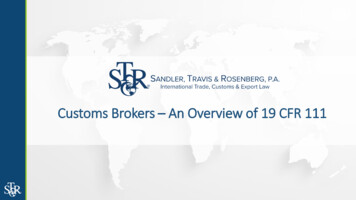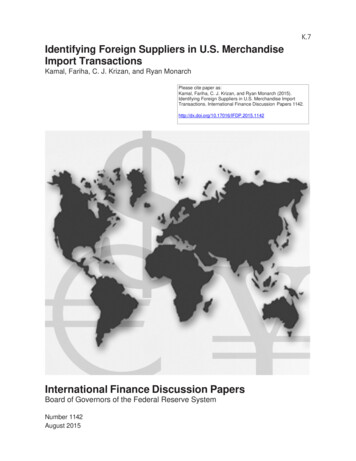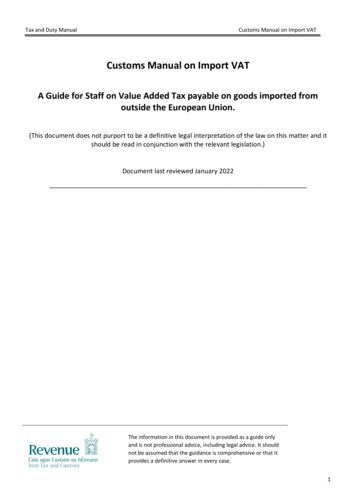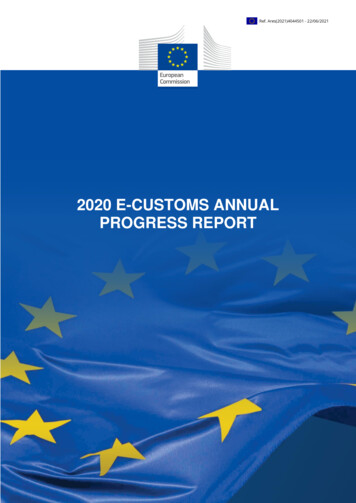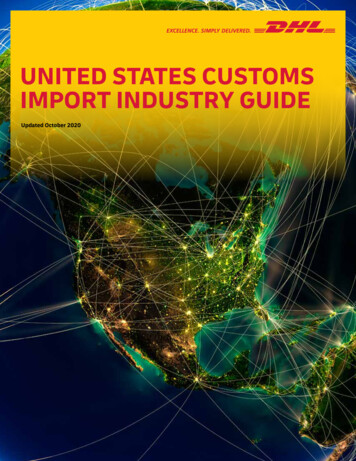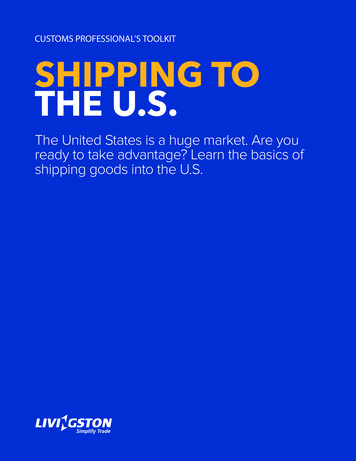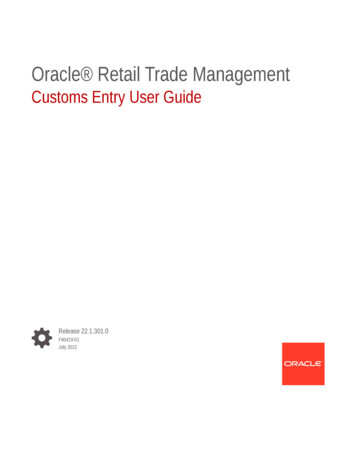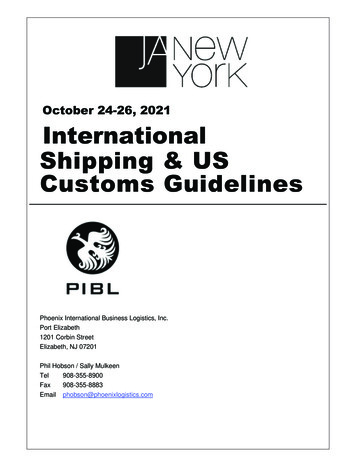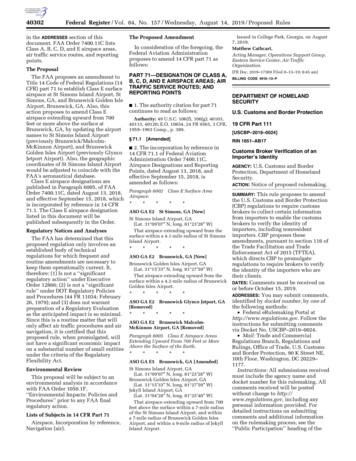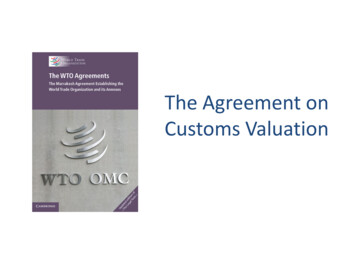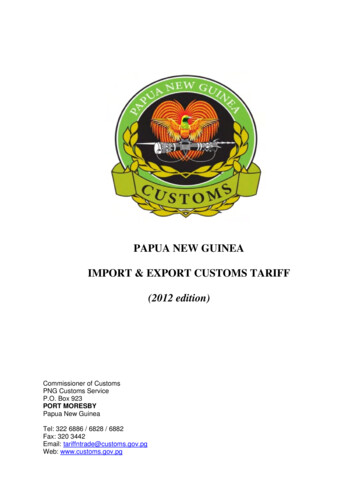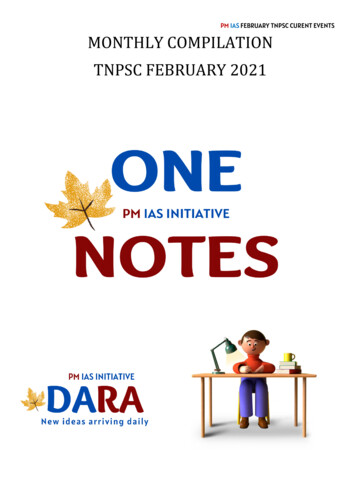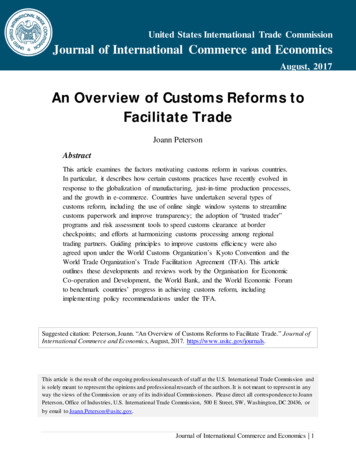
Transcription
United States International Trade CommissionJournal of International Commerce and EconomicsAugust, 2017An Overview of Customs Reforms toFacilitate TradeJoann PetersonAbstractThis article examines the factors motivating customs reform in various countries.In particular, it describes how certain customs practices have recently evolved inresponse to the globalization of manufacturing, just-in-time production processes,and the growth in e-commerce. Countries have undertaken several types ofcustoms reform, including the use of online single window systems to streamlinecustoms paperwork and improve transparency; the adoption of “trusted trader”programs and risk assessment tools to speed customs clearance at bordercheckpoints; and efforts at harmonizing customs processing among regionaltrading partners. Guiding principles to improve customs efficiency were alsoagreed upon under the World Customs Organization’s Kyoto Convention and theWorld Trade Organization’s Trade Facilitation Agreement (TFA). This articleoutlines these developments and reviews work by the Organisation for EconomicCo-operation and Development, the World Bank, and the World Economic Forumto benchmark countries’ progress in achieving customs reform, includingimplementing policy recommendations under the TFA.Suggested citation: Peterson, Joann. “An Overview of Customs Reforms to Facilitate Trade.” Journal ofInternational Commerce and Economics, August, 2017. https://www.usitc.gov/journals.This article is the result of the ongoing professional research of staff at the U.S. International Trade Commission andis solely meant to represent the opinions and professional research of the authors. It is not meant to represent in anyway the views of the Commission or any of its individual Commissioners. Please direct all correspondence to JoannPeterson, Office of Industries, U.S. International Trade Commission, 500 E Street, SW, Washington, DC 20436, orby email to Joann.Peterson@usitc.gov.Journal of International Commerce and Economics 1
An Overview of Customs Reforms to Facilitate TradeIntroduction: The Changing Role of CustomsCustoms administrations perform broad, important functions that facilitate the flow of goods andservices across international borders. Traditionally, customs has played a somewhat narrow role,focused primarily on the collection of duties and taxes on imported goods. In the United States,for example, revenue collected by the U.S. Customs Service (USCS)—now the Bureau ofCustoms and Border Protection (CBP)—was a significant source of income for the U.S.economy before the establishment of the federal income tax system. 1 Over time, the role ofUSCS expanded so that, in addition to revenue collection, it became responsible for ensuring thelegitimacy, safety, and security of goods admitted into the United States. Currently, CBP carriesout this responsibility, in conjunction with other U.S. government agencies, through itsenforcement of a range of trade laws, including those concerning tariff collection, compliancewith sanitary and phytosanitary standards, and the protection of intellectual property rights. 2More recently, CBP, like other customs administrations worldwide, has been asked to take on therole of trade facilitator. 3 This role requires the CBP to adopt specific practices that allow importsinto the United States to clear customs checkpoints more efficiently. These improved practicesare also being adopted by other countries and advanced under both the World CustomsOrganization (WCO) and the World Trade Organization (WTO), as discussed later in this article.In many developing countries, however, customs agencies are still seen principally as taxcollecting entities, even as trade promotion is acknowledged as increasingly vital to thesecountries’ economic growth. 4 The cost of trade activity in developing countries is estimated to be1.8 times higher, on average, than in developed countries. 5 These costs arise not from higher1Jones and Seghetti, U.S. Customs and Border Protection, May 18, 2015, 8–9. USCS was established by Congresson July 31, 1789 and was placed under the purview of the Secretary of the Treasury on September 2, 1789. In 2003,USCS became the Bureau of Customs and Border Protection (CBP) under the newly-established Department ofHomeland Security, created by the Homeland Security Act of 2002 (P.L. 107-296).2Jones and Seghetti, “U.S. Customs and Border Protection: Trade, Enforcement, and Security: Summary,”Congressional Research Service (CRS), May 18, 2015, 26. In the United States, customs clearance involves not onlyCBP, but other U.S. government agencies responsible for verifying the legitimacy, safety (e.g. through product,sanitary, and phytosanitary standards), and security (i.e., ensuring that dangerous goods do not enter the UnitedStates) of U.S. imports. These agencies include, for example, the U.S. Department of Agriculture, the U.S.Environmental Protection Agency, the U.S. Drug Enforcement Agency, and the U.S. Patent and Trademark Office.An exporter into the United States may therefore have to complete paperwork from multiple agencies to clear goodsat the border—the streamlining of such paperwork into a unified online platform is part of the concept behind thesingle customs window.3Jones and Seghetti, “U.S. Customs and Border Protection: Trade, Enforcement, and Security: Summary,”Congressional Research Service (CRS), May 18, 2015, 3. This report describes the current role of CBP ascomprising trade enforcement, import security, and trade facilitation. Whereas trade enforcement concerns theenforcement of IPR and tariff laws, for example, import security concerns the identification of dangerous or illicitgoods (including “chemical, biological, radiological and nuclear (CBRN) weapons and related material; illegaldrugs; and contraband”).Trade facilitation, on the other hand, pertains to the efficiency with which goods are clearedthrough customs checkpoints.4Njinkeau and Hartmann, “Unlocking Trade for Low-Income Countries,” October 2015, 70. In sub-Saharan Africa(SSA), dependence on customs revenue and import duties varied greatly. In Lesotho, these duties accounted for anaverage of nearly 40 percent of GDP between 2006 and 2008; in Nigeria and Tanzania during the same period, theyaccounted for only about 1 percent. Zake, “Customs Administration Reform and Modernization in AnglophoneAfrica,” August 2011.5WCO, “Statement by Mr. Joakim Reiter, Deputy Secretary-General,” June 1, 2016.Journal of International Commerce and Economics 2
An Overview of Customs Reforms to Facilitate Tradetariffs but from nontariff barriers (NTBs) such as inefficient customs procedures and inadequatetransport and communications infrastructure. 6In an increasingly globalized world, where goods (and people) cross borders with morefrequency, and where speed to market is of utmost importance for both supply chain participantsand end consumers, customs administrations are now asked to both facilitate legitimate trade andprotect borders. 7 However, it is often difficult for customs administrations to strike a balancebetween these two functions, which can often undercut one another. This is especially true whenchanges in political or economic circumstances require customs administrations to giveimmediate priority to either import security or trade facilitation. 8Trends Influencing Customs ReformThe globalization of supply chains, the expansion of just-in-time (JIT) manufacturing, and thegrowth of e-commerce have stimulated efforts toward customs reform. At present, more thanhalf of all goods that cross international borders are intermediate goods, reflecting the geographicfragmentation of production networks and an increase in vertical specialization. 9 Intermediateinputs account for a large share (more than 50 percent) of participation in global value chains bythe United States, as well as by many other countries, whether members of the Organisation forEconomic Co-operation and Development (OECD) or not. 10 JIT manufacturing means that theseintermediate parts must arrive at the next point in the global value chain within a tight deadline. 11In addition, business-to-business, business-to-consumer, and consumer-to-consumer e-commercehave boosted demand for faster, more efficient customs clearance procedures. According toestimates by UNCTAD, business-to-business e-commerce accounted for 15 trillion in revenuesin 2013, and business-to-consumer e-commerce for 1 trillion. 12 At the same time, the number ofsmall packages processed by customs administrations rose by 48 percent between 2011 and6Ibid.Jones and Seghetti. “U.S. Customs and Border Protection: Trade, Enforcement, and Security,” CongressionalResearch Service, May 18, 2015, 3; Ruda, “Using Automation to Balance Border Security and TradeLiberalization,” July 26, 2016. The confluence of goods and people crossing international borders, and the need forcountries to develop a concerted approach to managing both activities, has caused them to move towards moreholistic “border management” reform efforts, which encompass more than just customs.8Jones and Seghetti, “U.S. Customs and Border Protection: Trade, Enforcement, and Security,” CongressionalResearch Service, May 18, 2015, 2–3.9OECD, Mapping Global Value Chains, December 3, 2012, 2–3, 5–6. OECD research suggests that value-creationis concentrated heavily in countries that perform upstream activities or the production of components and inputs tofinal products rather than in countries that perform downstream activities, or final product assembly. Interruption inupstream activities of global value chains (GVCs) may cause additional costs and delays for downstream producersin such industries as electronics and automobile manufacturing. Vertical specialization refers to a countryspecializing in a particular stage of manufacturing (e.g., producing components or assembling final products) inwhich it may have a comparative advantage.10OECD, Mapping Global Value Chains, TAD/TC/WP/RD (2012)9, December 3, 2012, 24–25. Calculations ofOECD and non-OECD country participation in GVCs using 2008 data are presented in figures 1 and 2 of the paperon pages 12–13.11De Wulf and Sokol, Customs Modernization Handbook, 2005, 6. JIT manufacturing refers to the assembly ofgoods on demand from the customer, often through the sourcing of primary and intermediate inputs from disparatelocations. Among other things, JIT manufacturing helps firms to lower inventory holding costs, but it requiresnimble supply chains to succeed.12These amounts pertain to both domestic and international e-commerce transactions. WTO, “International TradeStatistics 2015,” 2015, 31.7Journal of International Commerce and Economics 3
An Overview of Customs Reforms to Facilitate Trade2014. The latter development is largely but not entirely accounted for by e-commercetransactions. 13A fourth trend is growing regional economic integration, especially in the form of free tradeagreements (FTAs), customs unions, and trade (or transit) corridors. 14 In general, FTAs andcustoms unions are designed to liberalize market access for participating countries by removingtrade barriers, including customs barriers, while trade corridors are developed to facilitate tradebetween landlocked countries and their coastal neighbors. 15 According to the World TradeOrganization (WTO), at the start of 2017 there were 238 FTAs and 19 customs unions in forcethat had been notified under the General Agreement on Trade and Tariffs (GATT). 16 Countriesthat are a party to these agreements aim to harmonize customs procedures and regulations.Customs unions, in particular, are formed between countries that share borders, and theseagreements require member countries to coordinate border management policies. In addition,members of customs unions develop a common external tariff that applies to trade with thirdparty countries, whereas trade among customs union members is duty free. 17 By contrast, tradecorridors focus on upgrading transport infrastructure; however, they are most effective whenaccompanied by improvements in customs efficiency. 18Finally, and most importantly, there is strong evidence that customs reform is motivated by adesire to lower significant costs to trade. Some of these costs, often referred to as NTBs ornontariff measures (NTMs) affecting trade, 19 are financial in nature, as they involve directpayment. Others, such as time delays, ultimately lower corporate profitability but may notnecessarily take the form of direct payments. 20 It has been shown that NTMs can add 70 percent13WTO, “International Trade Statistics 2015,” 2015, 31.WTO, “Regional Trade Agreements and Preferential Trade Agreements” (accessed October 11, 2016).Under the WTO, FTAs and customs unions are considered two forms of regional trade agreements (RTAs). TheWTO defines RTAs as “reciprocal trade agreements between two or more partners.”15WTO, “Regional Trade Agreements and Preferential Trade Agreements,” n.d.https://www.wto.org/english/tratop e/region e/rta pta e.htm (accessed October 11, 2016). Article XXIV of theGeneral Agreement on Tariffs and Trade (GATT) exempts countries that have formed customs unions or FTAs frommost-favored nation (MFN) principles that require the nondiscriminatory treatment of GATT signatories by partiesto the agreement. McLinden et al., Border Management Modernization, 2011, 233.16WTO, “Some Figures on Regional Trade Agreements,” updated December 22, 2016.McLinden, Fanta, Widdowson, and Doyle, eds., Border Management Modernization, 2011 (Washington, DC: TheWorld Bank), 232. Overall, customs unions exist midway along a spectrum of regional integration agreements. Theleast restrictive of these are partial-scope agreements and FTAs, and the most restrictive are common markets andeconomic and monetary unions. For more information see box 14.1, “The Five Stages of Regional Integration,” inBorder Management Modernization, page 232. Countries may exempt certain sectors or products from the CET.Andriamananjara, “Customs Unions,” June 2011, 115.18Kunaka and Carruthers, Trade and Transport Management Toolkit, 2014, 3–11.19McLinden, Fanta, Widdowson, and Doyle, eds., Border Management Modernization, 2011 (Washington, DC: TheWorld Bank), 215. In place of NTBs, the broader term “nontariff measures (NTMs),” is often used. NTMs includeregulatory measures such as sanitary and product standards that, although necessary, may also serve to impede theflow of trade. The term NTM will be used in the remainder of this article.20Li and Wilson, “Time as a Determinant of Comparative Advantage,” November 1, 2009, 4. Overall, time delaysadd two dimensions to costs: inventory-holding costs and depreciation costs. Time delays may also adversely affecttrade in time-sensitive goods, including JIT inventory (e.g., electronics) and perishable products.14Journal of International Commerce and Economics 4
An Overview of Customs Reforms to Facilitate Tradeto the restrictiveness of tariffs alone 21 and that countries that have lessened customs barriers tendto enjoy both more diverse exports and more export intensity. 22Djankov estimates that for a single country, a one-day delay in goods reaching their destinationis equivalent to reducing the country’s overall trade by 1 percent or to adding 70 kilometers oftransport distance. Delays in time-sensitive goods result in a more striking outcome: a reductionin trade by as much as 6 percent. Large firms that are able to absorb the costs of time delays aremore likely to trade nonetheless, while these costs may keep small firms from engaging in crossborder transactions altogether. 23 The desire to avoid these costs can stimulate firms toreconfigure their supply chains, to lessen the amount that they trade, or to alter the compositionof traded goods. 24 Therefore, to the extent that they understand that trade is often an importantdriver of economic growth, countries have worked toward eliminating inefficient customsprocedures that serve as NTMs to trade. 25The WCO’s Kyoto Convention Provides a Framework forCustoms ReformThe International Convention on the Simplification and Harmonization of Customs Procedures,also known as the Kyoto Convention, was established in 1974 under the World CustomsOrganization (WCO). It was revised in 1999 to reflect changes in the speed of commerce and theadvancement of information technology. 26 The principles outlined in the Kyoto Conventionprovide both the impetus and a roadmap for customs reform efforts by signatory countries. 27Currently, 105 countries are signatories to the revised Kyoto Convention. 28Among its core principles, the revised Kyoto Convention promotes the transparency,simplification, standardization, and harmonization of customs procedures. This is achieved by,for example, the online publication of customs rules and regulations; the streamlining of customspaperwork; the use of electronic platforms for customs filing and clearance; the adoption of riskmanagement tools for customs inspections that separate high-risk (e.g., potentially dangerous orillegal) cargo from low-risk cargo; and coordination between the border management agencies ofsignatory countries. 29 In 2005, the WCO reinforced the principles set out under the revised21Kee, Nicita, and Olarreaga, “Estimating Trade Restrictiveness Indices,” December 2005, 20. The 70 percentrepresents an average amount for the 91 countries covered in the study.22Kee, Nicita, and Olarreaga, “Estimating Trade Restrictiveness Indices,” World Bank, December 2005, 20; Li, Yueand John S. Wilson, “Time as a Determinant of Comparative Advantage,” World Bank Research Working Paper No.5128, November 1, 2009, 9. Export intensity denotes the ratio of exports to a firm’s total sales.23Djankov, Freund, and Pham, “Trading on Time,” World Bank, 2010, 20–21.24Djankov, Freund, and Pham, “Trading on Time,” World Bank, 2010, 21.25McLinden, Fanta, Widdowson, and Doyle, eds., Border Management Modernization, 2011 (Washington, DC: TheWorld Bank), 215.26WCO, “The Revised Kyoto Convention,” 2015. The revised Kyoto Convention became effective on February 3,2006.27WCO, “The Revised Kyoto Convention,” 2015.28WCO, “Position as Regards Notifications and Accessions,” October 27, 2016.29WCO, “The Revised Kyoto Convention,” 2015. Using risk management techniques at border crossings reducesbottlenecks at customs checkpoints by limiting physical inspections, allowing customs officials to focus on findingand checking high-risk cargo. OECD, “The Costs and Benefits of Trade Facilitation,” October 2005, 6.Journal of International Commerce and Economics 5
An Overview of Customs Reforms to Facilitate TradeKyoto Convention with the introduction of the Framework of Standards to Secure and FacilitateTrade (SAFE) (box 1). 30Box 1: The WCO SAFE Framework Promotes Supply Chain Security and Trade FacilitationTHE WCO’s Framework of Standards to Secure and Facilitate Trade (SAFE Framework) was developedin 2005. Revisions between 2007 and 2015 reflected changes in global supply chains, the role ofinformation technology in border security, and the incorporation of authorized economic operators(AEO). 31 Some of the primary objectives of the SAFE Framework are to: Establish standards on supply chain security and trade facilitation that foster “certainty andpredictability” in the global trading system;Enhance “the role, functions, and capability” of customs administrations to promote and secure globaltrade;Expand cooperation between customs administrations of separate countries (i.e., through customs-tocustoms cooperation), between customs administrations and other government agencies within thesame country, and between customs administrations and private-sector entities (i.e., through customsbusiness partnerships); andEnable global supply chains to operate in a secure and seamless manner. 32The SAFE Framework is designed to ensure the security of goods as they move through global valuechains. However, SAFE’s emphasis on cooperation among customs administrations, and betweencustoms and the other public and private entities, underscores its commitment to trade facilitation.Following the WCO’s Integrated Supply Chain Management guidelines, customs administrations worktogether to detect dangerous or illegal goods by sharing customs data, intelligence on potential threats,and risk profiles. 33 The SAFE Framework recommends that customs administrations use informationtechnology to gather, store, and analyze data on high-risk cargo, and that they require shippers to provideinformation on imports in electronic format before the items arrive at customs checkpoints to helpcustoms officials assess risk. 34The AEO program complements the objectives of the SAFE Framework by enabling private-sectorentities, including importers, exporters, customs brokers, freight forwarders, and transportation serviceproviders, to be registered by their county’s customs authority as a “trusted trader.” AEO participants arerequired to share company information with customs administrations and to show they are complyingwith WCO guidelines to ensure the security of supply chain operations. In return, AEO members benefitfrom simplified customs procedures and the expedited clearance of their goods. The WCO alsorecommends that customs administrations provide mutual recognition of AEO members in other countriesboth to enhance import security and to facilitate trade.30Yasui, “Benefits of the Revised Kyoto Convention,” 2010, 6.WCO, “WCO SAFE Package,” n.d. (accessed October 24, 2016). An AEO is an entity involved in internationaltrade which has demonstrated to its customs administration that it complies with WCO supply chain securitystandards. For more information, see WCO, Compendium of Authorized Economic Operator Programmes, 2016.The compendium states that 69 AEO programs are in place globally, with another 16 to be introduced. ThomsonReuters, “China New Authorized Economic Operator System,” July 3, 2015.32WCO, “SAFE Framework of Standards,” June 2015, 2.33WCO, “SAFE Framework of Standards,” June 2015, 2.34WCO, “SAFE Framework of Standards,” June 2015, 1, 6, 15. While Electronic Data Interchange (EDI) systemsare commonly used to exchange relevant information between customs administrations and exporters, importers, andshippers, the SAFE Framework states that customs should “offer more than one solution for the electronic exchangeof information,” according to Kyoto Convention guidelines.31Journal of International Commerce and Economics 6
An Overview of Customs Reforms to Facilitate TradeIn the United States, trusted traders are registered under the CBP’s Customs-Trade PartnershipAgainst Terrorism (C-TPAT). 35 As of July 2016, the CBP signed 11 mutual recognitionarrangements with the customs administrations of other countries, including, for example,Canada, the European Union (EU), Japan, South Korea, Mexico, and Singapore. Although themutual recognition arrangements are nonbinding, they promote transparency, a sharedresponsibility for managing high-risk cargo, and common standards for supply chain security andtrade facilitation. 36Provisions in the revised Kyoto Convention are designed to facilitate trade by reducing NTMs atborder checkpoints. 37 For firms, these benefits translate into reduced data requirements, fastercustoms clearance times, “green lanes” for low-risk cargo, and more predictable release times forgoods. 38 In addition, acceding to the Kyoto Convention is a useful way for countries to signal totheir trade partners that they plan to follow international customs standards. This, in turn, maylead to higher imports and customs revenue, more foreign direct investment, lower trade costs,and higher GDP. 39Following the principles outlined in the revised Kyoto Convention, many countries have pursuedcustoms reforms. Developed countries, in particular, have led in implementing institutionalreforms (often referred to as the “soft” infrastructure of customs) that reduce customsinefficiency, increase transparency, and decrease opportunities for corruption by customsofficials. 40 A central element of institutional reform is the automation of customsdocumentation. 41 For instance: In 2008, the European Parliament passed legislation on an “electronic customs initiative”intended to facilitate the online exchange of customs declarations among EU members. 42Among other things, the legislation aimed to enhance customs data flow among EUcountries; facilitate import and export procedures; reduce the administrative costs35For more information on the origin of C-TPAT, see Peterson and Treat, “The Post 9/11 Global Framework forCargo Security,” September 2009, 9–11.36USCBP, “C-TPAT: FAQ,” January 2015; USCBP, “Customs-Trade Partnership against Terrorism MutualRecognition,” updated August 23, 2016. Language aimed at strengthening cooperation among members of C-TPATis part of the United States’ Trade Facilitation and Trade Enforcement Act of 2015 (H.R. 644), which was signedinto law on February 24, 2016. The law also requires USCBP to develop performance criteria to assess the progressof its trade facilitation and trade enforcement activities. Kulisch, “House Passes Customs Reauthorization Bill,”December 14, 2015.37Yasui, “Benefits of the Revised Kyoto Convention.” World Customs Organization, 2010, 4.38Thomson Reuters and KPMG International, “2016 Global Trade Management Survey,” 2016, 4–8. Firms havehighlighted several issues related to customs compliance as adding uncertainty to their international operations,including the difficulty of interpreting customs rules across countries and the use of manual rather than automatedsystems for filing customs documentation.39Yasui, “Benefits of the Revised Kyoto Convention.” World Customs Organization, 2010, 5.40Cantens et al., “Reforming African Customs,” January 2011, 2; Barka, “Border Posts, Checkpoints, and IntraAfrican Trade,” January 2012, 4. Some forms of customs fraud and corruption are smuggling or pilferage of importsand exports; undervaluation of imports; incomplete customs documentation; and the requirement for “facilitativepayments” by customs officials for clearance.41World Bank, “Good Practices,” 2016. The use of information technology to automate customs processes must besupported by regulatory reform. Such reform eliminates redundancies in customs procedures and ensures thatcustoms administrations do not require paperwork in addition to the electronic submission of customsdocumentation.42Official Journal of the European Union, Decisions Adopted Jointly by the European Parliament and the Council,“Decision No. 70/2008/EC of the European Parliament and of the Council of 15 January 2008 on a PaperlessEnvironment for Customs and Trade,” January 26, 2008.Journal of International Commerce and Economics 7
An Overview of Customs Reforms to Facilitate Trade associated with customs processing; decrease clearance times; and enable the accuratecollection of customs duties. 43Japan has developed an online platform to process both air and maritime imports andexports, called the Nippon Automated Cargo and Port Consolidated system (NACCS).NACCS streamlines customs paperwork into a single electronic interface, therebyallowing importers, exporters, customs brokers, shippers, and logistics service providersto enter, retrieve, and share customs-related data with their business partners. 44The United States is in the process of implementing the Automated CommercialEnvironment (ACE), a single window platform which is to become fully operational in2017 (box 2). Like the automated customs environments in the EU and Japan, theprimary objectives of ACE are to increase the efficiency and transparency of customsprocedures by streamlining documentation, eliminating paperwork, and facilitating theexchange of information between traders and border agencies. 45Box 2: Digital Customs Is Advanced through Online Single WindowsAmong the recommendations of the WCO to advance trade facilitation, setting up an online portal for thesubmission of all customs-related documentation, known as a “single window,” is perhaps the mostimportant. In addition to improving the efficiency, speed, and transparency of customs processing, singlewindows streamline time-consuming and often redundant paperwork for customs approvals, as well asreduce the opportunity for corrupt practices among customs officials. They also facilitate the electronicexchange of information between customs authorities and other government agencies, as well as betweenthe customs administrations of trade partners. 46Many countries have implemented, or are in the process of implementing, single window systems. Thesecountries represent a broad spectrum of economic development, from Australia, Singapore, Sweden, andthe United States to Benin, Colombia, Indonesia, and Vietnam, among others. The degree to which singlewindows replace traditional paper-based systems varies. In some countries, for example, single windowsystems are used to process all customs documentation, including documents pertaining to othergovernment certifications, such as sanitary and phytosanitary standards. In other countries, singlewindows coexist alongside paper-based systems, diminishing the time and cost savings that the formerprovides. The latter may occur where countries lack adequate information technology to fully implementan electronic single window or in countries that must first establish a supportive regulatory environmentto bypass traditional paper-based systems, as is the case in certain sub-Saharan African (SSA) countries. 47Colombia’s single window system, Ventanilla Única de Comercio Exterior (VUCE), exemplifies theoptimal use of a digital customs window. VUCE enables users to obtain online approvals, authorizations,and certifications required for customs clearance from more than 20 government agencies, connectingthese entities with ex
2 Jones and Seghetti, "U.S. Customs and Border Protection: Trade, Enforcement, and Security: Summary," Congressional Research Service (CRS), May 18, 2015, 26. In the United Stat es c, ustoms celarance ni vovl es not onyl CBP , but other US. . government agenceis responsbi el for verfiyni g the legtimi acy , safety (eg. .through product ,
